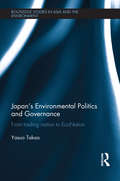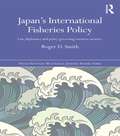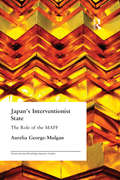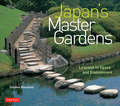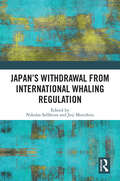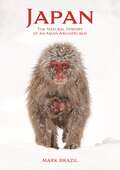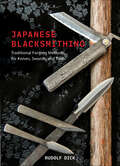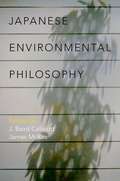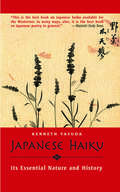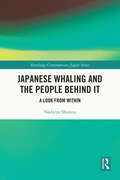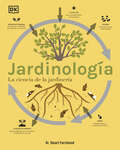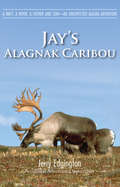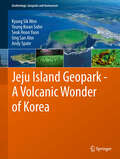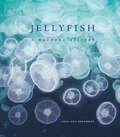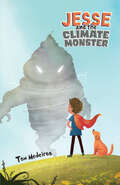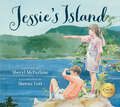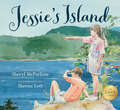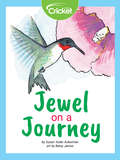- Table View
- List View
Japan's Dietary Transition and Its Impacts
by Vaclav Smil Kazuhiko KobayashiIn a little more than a century, the Japanese diet has undergone a dramatic transformation. In 1900, a plant-based, near-subsistence diet was prevalent, with virtually no consumption of animal protein. By the beginning of the twenty-first century, Japan's consumption of meat, fish, and dairy had increased markedly (although it remained below that of high-income Western countries). This dietary transition was a key aspect of the modernization that made Japan the world's second largest economic power by the end of the twentieth century, and it has helped Japan achieve an enviable demographic primacy, with the world's highest life expectancy and a population that is generally healthier (and thinner) than that of other modern affluent countries. In this book, Vaclav Smil and Kazuhiko Kobayashi examine Japan's gradual but profound dietary change and investigate its consequences for health, longevity, and the environment. Smil and Kobayashi point out that the gains in the quality of Japan's diet have exacted a price in terms of land use changes, water requirements, and marine resource depletion; and because Japan imports so much of its food, this price is paid globally as well as domestically. The book's systematic analysis of these diverse consequences offers the most detailed account of Japan's dietary transition available in English.
Japan's Dietary Transition and Its Impacts (Food, Health, and the Environment)
by Vaclav Smil Kazuhiko KobayashiAn examination of the transformation of the Japanese diet from subsistence to abundance and an assessment of the consequences for health, longevity, and the environment.In a little more than a century, the Japanese diet has undergone a dramatic transformation. In 1900, a plant-based, near-subsistence diet was prevalent, with virtually no consumption of animal protein. By the beginning of the twenty-first century, Japan's consumption of meat, fish, and dairy had increased markedly (although it remained below that of high-income Western countries). This dietary transition was a key aspect of the modernization that made Japan the world's second largest economic power by the end of the twentieth century, and it has helped Japan achieve an enviable demographic primacy, with the world's highest life expectancy and a population that is generally healthier (and thinner) than that of other modern affluent countries. In this book, Vaclav Smil and Kazuhiko Kobayashi examine Japan's gradual but profound dietary change and investigate its consequences for health, longevity, and the environment.Smil and Kobayashi point out that the gains in the quality of Japan's diet have exacted a price in terms of land use changes, water requirements, and marine resource depletion; and because Japan imports so much of its food, this price is paid globally as well as domestically. The book's systematic analysis of these diverse consequences offers the most detailed account of Japan's dietary transition available in English.
Japan's Environmental Politics and Governance: From Trading Nation to EcoNation (Routledge Studies in Asia and the Environment)
by Yasuo TakaoEnvironmental issues stretch across scales of geographic space and require action at multiple levels of jurisdiction, including the individual level, community level, national level, and global level. Much of the scholarly work surrounding new approaches to environmental governance tends to overlook the role of sub-national governments, but this study examines the potential of sub-national participation to make policy choices which are congruent with global strategies and national mandates. This book investigates the emerging actors and new channels of Japan’s environmental governance which has been taking shape within an increasingly globalized international system. By analysing this important new phenomenon, it sheds light on the changing nature of Japan’s environmental policy and politics, and shows how the links between global strategies, national mandates and local action serve as an influential factor in Japan’s changing structures of environmental governance. Further, it demonstrates that decision-making competencies are shared between actors operating at different levels and in new spheres of authority, resulting from collaboration between state and non-state actors. It highlights a number of the problems, challenges, and critiques of the actors in environmental governance, as well as raising new empirical and theoretical puzzles for the future study of governance over environmental and global issues. Finally, it concludes that changes in the tiers and new spheres of authority are leading the nation towards an environmentally stable future positioned within socio-economic and political constraints. Demonstrating that bridging policy gaps between local action, national policy and global strategies is potentially a way of reinventing environmental policy, this book will be of interest to students and scholars of Environmental Studies, Environmental Politics and Japanese Politics.
Japan's International Fisheries Policy: Law, Diplomacy and Politics Governing Resource Security (Nissan Institute/Routledge Japanese Studies)
by Roger D. SmithFew nations rely upon the ocean as much as Japan for livelihood, culture and transport. The seas have long played a vital role for the Japanese, helping to support the economic and social life of a nation that possesses few resources and little arable land, and sustain a population that has nearly tripled in the last century. Fish are a distinctive feature of the Japanese diet, constituting nearly half of all animal protein consumed – the highest rate in the world. The industry itself has provided an impetus for coastal community growth and national economic development over the past century, while fisheries have worked their way into Japanese culture and customs, serving as a dominant symbol in traditional arts and folklore. This book explores the overarching rationale that motivated Japanese international fisheries policy throughout the post-war period until today, highlighting the importance of international fisheries to Japan and the stature this resource has occupied as a national interest. It provides a comparative view of Japanese foreign policy at various ocean conferences, treaty negotiations, bilateral diplomatic initiatives and other maritime relations that constitute ocean policy over half a century, and investigates the domestic constituents of national policy. Roger Smith argues that the rationale for international fisheries policy may be best viewed as deriving from Japan’s unique defence strategy for its national interests: comprehensive security. Encompassing non-military elements and most importantly defence of economic interests, Japan’s international fisheries policy provides an interesting case study of how comprehensive security is conceptualised and carried out. Taking a broad view of Japan’s international fisheries policies from 1945 to the present, this book highlights the key trends in policy motives and means throughout the post-war period. As such, it will be of great interest to students and scholars of Japanese studies, international and environmental law, resource management and international relations, as well as to policy makers working in the field.
Japan's Interventionist State: The Role of the MAFF (Nissan Institute/Routledge Japanese Studies)
by Aurelia George-MulganJapan's Interventionist State gives a detailed examination of Japan's Ministry of Agriculture, Forestry and Fisheries and its role in promoting, protecting and preserving the regime of agricultural support and protection. This account is integral to the author's extended and multidimensional explanation for why Japan continues to provide high levels of assistance to its farmers and why it continues to block market access concessions in the WTO and other agricultural trade talks.
Japan's Master Gardens
by Stephen MansfieldNo two Japanese gardens are ever the same. Each is inimitable, yet embodies commonalities of design and aesthetic taste. Each finds the space for innovation within a tradition that benefits from a thousand years of applied knowledge. Presenting twenty-five master gardens, Japan's Master Gardens explores the ingenuity and range of Japanese landscaping, from the self-imposed confines of courtyard designs to the open expanses of the stroll garden.Japan's Master Gardens illustrates how, through the ministrations of generations of gardeners, original landscapes have maintained their mastery and demonstrates how contemporary landscaping draws from tradition, making ancient gardens relevant to the lives of people in the twenty-first century.This beautifully illustrated book takes readers on an exploration of the outward forms, underpinning principles, complex use of metaphor and allusion, and beauty and depth that set the Japanese garden apart.
Japan's Withdrawal from International Whaling Regulation
by Nikolas Sellheim Joji MorishitaThis book examines the impact and implications of Japan's withdrawal from the International Convention for the Regulation of Whaling (ICRW), which came into effect in July 2019. In 1982 the International Whaling Commission (IWC) adopted a moratorium on commercial whaling which has been in effect ever since, despite the resistance of some countries, first and foremost Japan, Norway and Iceland, that engage in commercial whaling. As one of the key contributors to scientific research and funding, Japan's withdrawal has the potential to have wide-ranging implications and this volume examines the impact of Japan's withdrawal on the IWC itself, on the governance of whaling, and on indigenous and coastal whaling. It provides backgrounds and commentaries on this decision as well as normative and legal discussions on matters relating to sustainable use of resources, and philosophies surrounding whaling in different IWC countries. The consideration of other international environmental regimes, such as the Convention on International Trade in Endangered Species (CITES) are also examined in order to determine the international ripple effect of Japan’s decision. The book reveals that this is not just a matter of whaling but one which has significant legal, managerial and cultural implications. Drawing on deep analyses of IWC structures, the book addresses core philosophies underlying the whaling debate and in how far these may influence environmental governance in the future. This book will be of great interest to students and scholars of environmental law and governance, biodiversity conservation and sustainable development, as well as policymakers involved in international environmental and conservation agreements.
Japan's Withdrawal from International Whaling Regulation (Routledge Studies in Conservation and the Environment)
by Nikolas Sellheim Joji MorishitaThis book examines the impact and implications of Japan’s withdrawal from the International Convention for the Regulation of Whaling (ICRW), which came into effect in July 2019. In 1982 the International Whaling Commission (IWC) adopted a moratorium on commercial whaling which has been in effect ever since, despite the resistance of some countries, first and foremost Japan, Norway and Iceland, that engage in commercial whaling. As one of the key contributors to scientific research and funding, Japan’s withdrawal has the potential to have wide-ranging implications and this volume examines the impact of Japan’s withdrawal on the IWC itself, on the governance of whaling, and on indigenous and coastal whaling. It provides backgrounds and commentaries on this decision as well as normative and legal discussions on matters relating to sustainable use of resources, and philosophies surrounding whaling in different IWC countries. The consideration of other international environmental regimes, such as the Convention on International Trade in Endangered Species of Wild Fauna and Flora (CITES), is also examined in order to determine the international ripple effect of Japan’s decision. The book reveals that this is not just a matter of whaling but one which has significant legal, managerial and cultural implications. Drawing on deep analyses of IWC structures, the book addresses core philosophies underlying the whaling debate and in how far these may influence environmental governance in the future. This book will be of great interest to students and scholars of environmental law and governance, biodiversity conservation and sustainable development, as well as policymakers involved in international environmental and conservation agreements.
Japan: The Natural History of an Asian Archipelago (Wildlife Explorer Guides #18)
by Mark BrazilA comprehensive, richly illustrated guide to Japan’s astonishing animals and plants—and the natural forces that have shaped themThis richly illustrated guide is the first comprehensive and accessible introduction to the extraordinary natural history of the Japanese archipelago. It explains how Japan’s geology, geography, climate, seas and currents have forged conditions supporting a diverse range of species—from cranes, bears, eagles and monkeys to plants, butterflies, dragonflies, frogs and snakes—many of which are found nowhere else in the world. Engaging and authoritative, this book is a must-have for anyone who wants to explore or learn about Japan’s natural wonders, from the Japanese Macaque—the famous snow monkeys—to the magnificent Steller’s Eagle.Features more than 878 colour photographs, illustrations and mapsProvides a lavishly illustrated introduction to many of Japan’s common and iconic mammals and birdsTakes readers on a naturalist’s journey to the key areas of Hokkaido, Honshu, Kyushu, Shikoku and Nansei Shoto, as well as the Izu, Ogasawara and Iwo islandsIntroduces Japan’s geology, geography, topography, climate, habitats, biodiversity and much moreExplains where and how to watch and photograph wildlife in Japan, including whales
Japanese Blacksmithing: Traditional Forging Methods for Knives, Swords, and Tools
by Rudolf DickDiscover the blacksmithing techniques used to make 10 traditional Japanese objects with insights from the artisans and rare glimpses inside their workshops. The art of blacksmithing and steel processing didn't reach Japan until more than 1,000 years after it was developed in the Western world. It is therefore all the more astonishing to see the high culture of forging that developed in the Land of the Rising Sun within a short period of time. This comprehensive reference book explains the traditional methods used by Japanese tool-, knife-, and swordsmiths and gives the reader a rare and unique look inside their workshops. In these pages, readers will find • forging methods and techniques for 10 special products—hammer, chisel, axe, hatchet, gardener's machete, sickle, fish knife, folding knife, straight razor, and Japanese sword; • more than 150 color photographs that illustrate and explain the techniques used to create classic Japanese forged pieces; • chapters on Japan's oldest coppersmithing facility and traditional tatara steel smelting; and • helpful tables that detail the materials, chemistry, elements, and temperatures needed to harden, form, and manipulate the metal being forged. This is a must-have book, not only for amateur and professional smiths, but also for all admirers of Japanese craft culture.
Japanese Environmental Philosophy
by J. Baird Callicott James McRae<P>Japanese Environmental Philosophy is an anthology that responds to the environmental problems of the 21st century by drawing from Japanese philosophical traditions to investigate our relationships with other humans, nonhuman animals, and the environment. It contains chapters from fifteen top scholars from Japan, the United States, and Europe. <P>The essays cover a broad range of Japanese thought, including Zen Buddhism, Shintoism, the Kyoto School, Japanese art and aesthetics, and traditional Japanese culture.
Japanese Garden Design
by Marc P. Keane Haruzo OhashiThe creation of a Japanese garden combines respect for nature with adherence to simple principles of aesthetics and structure. In Japanese Garden Design, landscape architect Marc Peter Keane presents the history and development of the classical metaphors that underlie all Japanese gardens.Keane describes the influences of Confucian, Shinto and Buddhist principles that have linked poetry and philosophy to the tangible metaphor of the garden. Detailed explanations of basic design concepts identify and interpret the symbolism of various garden forms and demonstrate these principles in use today.
Japanese Haiku
by Kenneth YasudaThis is the most authoritative and concise book on Japanese haiku available: what it is, how it developed, and how it is practiced in both Japanese and English. While many haiku collections are available to Western readers, few books combine both translated haiku with haiku written originally in English, along with an analysis of individual poems and of the haiku form itself. Written by a leading scholar in the field--Kenneth Yasuda was the first American to receive a doctorate in Japanese literature from Tokyo University--Japanese Haiku has been widely acclaimed. This edition is completely repackaged for 2002, and is the perfect book for lovers of poetry who do not have a solid background in haiku.
Japanese Whaling and the People Behind It: A Look from Within (Routledge Contemporary Japan Series)
by Nadzeya ShutavaThis book explores the recent developments in global and Japanese whaling from the viewpoint of the members of the Japanese whaling community, a perspective that is largely neglected and misinterpreted. Japanese whaling has been one of the most contentious issues in global environmental governance in recent years, and Japan is often harshly criticized for its whaling programs. By distinguishing between the different whaling-related actors and their experiences, this book widens our understanding of why whaling programs continue to exist. Rich in ethnographic data, the book includes in-depth interviews with representatives of the Japanese whaling community, from government officials to fishermen, shedding light on what whaling represents, both historically and today. As an ethnographic study of a divisive and controversial subject, this book will appeal to a wide range of students and scholars, including, but not limited to, those interested in Japanese studies, anthropology, political science, and ocean resource management.
Japanese Woodblock Flower Prints
by Tanigami KônanExceptionally drawn in a realistic fashion and awash in spectacularly rich colors, this one-of-a-kind art book -- masterfully reprinted from a rare and costly edition -- combines the perennial appeal of flowers with the art of Japanese woodblock prints.Nothing expresses the richness and vigor of life like blooming flowers. A stunning showcase of 120 full-color plates, this specially chosen collection features beautiful Eastern and Western botanicals that will delight flower lovers, artists, designers, and devotees of fine art. Admire such familiar and unusual blossoms as the poppy, rose, anemone, cyclamen, delphinium, water lily, lupine, passion flower, allamanda, phlox, dahlia, petunia, tulip, freesia, pansy, begonia, and many more beautiful blooms!Tanigami Kônan (1879-1928) was a genius at the art of woodblock creation and color gradation, and he is still celebrated as one of the finest artists of this highly specialized technique. Captions and a complete index are included in this distinct keepsake edition.
Jardines (¡Arriba la Lectura!, Level I #10)
by Heather Hammonds Ben SpibyNIMAC-sourced textbook. ¡Cuesta mucho trabajo mantener un jardín! Pero los jardines son el hogar de animales e insectos, y son lugares hermosos. ¿Qué trabajos importantes puedes hacer en el jardín?
Jardinología (The Science of Gardening): La ciencia de la jardinería
by Dr. Stuart FarrimondUn libro de jardinería diferente que explica la ciencia detrás de la jardinería de forma visual y clara.¿El mundo de la botánica y la jardinería te parecen un misterio? Las guías de jardinería al uso tienden a dar gran cantidad de instrucciones y consejos, pero rara vez aportan explicaciones sobre el por qué. ¡No te preocupes! El Dr. Stuart Farromond arroja luz sobre todas esas preguntas que siempre te has hecho y te explica lo que sucede en tu jardín desde un enfoque científico.La guía botánica definitiva para entender los secretos de la horticultura y la floricultura como un profesional:Escrita con un lenguaje accesible y libre de tecnicismos en formato pregunta y respuesta. Con explicaciones claras, apoyadas por gráficos y esquemas para ilustrar los conceptos de forma visual.Estructurado en torno al ciclo de vida de un jardín, desde los primeros brotes hasta el momento de la poda.Explica los beneficios de la jardinería para la salud mental y el medio ambiente.Un práctico manual de jardinería con explicaciones y consejos avalados por la ciencia, que te ayudará a comprender mejor cómo se comportan las plantas, desmitificar creencias y descubrir las bases y avances de la horticultura moderna. ------------------------The only book to explain the science behind gardening practice in a simple and visually accessible way.The world of gardening can be a mystifying place, with so many instructions to follow and often little explanation as to why. Dr. Stuart Farromond casts his scientific eye over a typical year in the garden to answer all the horticultural questions you&’ve ever wanted the answer to. This great gardening book provides a shortcut to decades of gardening experience by explaining the science behind how a garden grows, featuring: An accessible guide structured around the life cycle of the garden, taking you from first shoots to pruning for renewal. An accessible Q &A format, with stats and infographics to bring the story to life, as well as long-held gardening myths are exploded by new science. Every way to greener fingers has an action point so that you can understand the science, apply your gardening practice, and enjoy a flourishing garden.From hands-on, practical advice, to an exploration of the mental health benefits of gardening, while also covering topics such as the positive impact gardening can have on the earth during a time of climate crisis in between, The Science of Gardening debunks myths and reveals the latest science only taught at horticultural college. As a passionate newcomer to gardening, daunted by the mountain of often conflicting advice in gardening manuals, Dr. Stu has set about testing the scientific basis of so much conventional wisdom and practice so you too can garden like a pro.
Jay's Alagnak Caribou: A Raft, A River, A Father and Son—An Unexpected Alaska Adventure
by Jerry EdgingtonJay and his dad knew things would change after summer. The seasons of boy scouts, little league, high school sports, and just hanging out, would be gone forever. But there was a chapter left to write, and it would be written on a long section of the Alagnak River in Alaska. It wouldn't be the final chapter, not by a long stretch, but it would be a transcending chapter. A self-guided moose hunt and fishing trip would be a proper way to commemorate Jay's 19th birthday. So, with fishing rods and guns, and a flight into the headwaters of the Alagnak River they embarked on their adventure. What they found was more than they imagined—much more. They found the Alaska wilderness and a freedom they didn't know existed. They found a life changing adventure—built unbreakable bonds.
Jaywalking with the Irish
by David MonaganFrom the book: For David Monagan, born in Connecticut to a staunch Irish-American family, a lifelong interest in Ireland was perhaps inescapable. David studied literature at Dublin's Trinity College in 1973 and '74, and he became captivated by the country. After enjoying many visits in the intervening years, in 2000 David and his family relocated from the U.S. to Cork, Republic of Ireland. David has written for numerous publications, including the Irish Times, Sunday Independent, and Irish Examiner, and in his wide travels has developed a keen eye for things baffling and marvelous, such as he finds everywhere around him in modern-day Ireland.
Jeju Island Geopark - A Volcanic Wonder of Korea
by Andy Spate Kyung Sik Woo Seok Hoon Yoon Ung San Ahn Young Kwan SohnThis book will deal with geological as well as cultural, historical, archaeological and biological aspects in Jeju Global Geopark. It will start with introduction of Jeju Global Geopark, geographic setting, habitats, history, economy and tourism, management, general geology and geosites, future geosites, other significant heritage sites, economically sustainable tourism, education and promotion and management plan.
Jellyfish: A Natural History
by Lisa-ann GershwinAn introduction to these bizarre and beautiful creatures of the sea, filled with color photos and illustrations: &“Fascinating.&”—Boing Boing Jellyfish are the oldest multi-organed life form on the planet, having inhabited the ocean for more than five hundred million years. With their undulating umbrella-shaped bells and sprawling tentacles, they are compelling and gorgeous, strange and dangerous. In many places they&’re also vastly increasing in number, and these population blooms may be an ominous indicator of the rising temperatures and toxicity of the oceans.Jellyfish presents these aquarium favorites in all their glory. Fifty unique species, from the purple people eater to black sea nettles, are presented in stunning photos along with the most current scientific information on their anatomy, history, distribution, position in the water, and environmental status. Foremost jellyfish expert Lisa-ann Gershwin provides an insightful look at the natural history and biology of each of these spellbinding creatures, plus a timely take on their place in the rapidly changing and deteriorating condition of the oceans. Learn about immortal jellyfish who live and die and live again—as well as those who camouflage themselves amid sea grasses and shells, hiding in plain sight. Discover the jellyfish that&’s the world&’s most venomous animal, and the jellyfish that helped scientists win the Nobel Prize. They&’re all here and more in this delightful volume. &“A thorough coverage of jellyfish history, biology and ecology. Gershwin, a marine biologist who has discovered over 200 new species of jellyfish, does an excellent job of combining a compelling narrative of 50 different jellyfish with luscious, I-can&’t-believe-they&’re-real photos.&”—Boing Boing
Jesse and the Climate Monster
by Tom MedeirosJesse and the Climate MonsterAn Introduction for parents and teachersAs the news of climate change and climate related disasters expands, our school age children are not immune to the feelings of fear and helplessness. Jesse and the Climate Monster, published as a bilingual (English/Spanish) book, allows young readers, their classmates and their families, an opportunity to begin to understand climate change as presented in an engaging tale. Within the story, early readers are exposed to many of the effects of climate change as Jesse relates the experiences of Jesse&’s classmates. In addition to the story, the accompanying links, activities, and illustrated glossary allow younger students, their classmates and their families, further access to climate information in an age-appropriate format. This story provides a ray of optimism, and a feeling of empowerment to our young readers. Jesse y el Monstruo ClimáticoUna introducción para padres y maestrosMientras que se difunden noticias de desastres relacionados con el clima, nuestros estudiantes jóvenes no son inmunes a sentimientos de miedo y desamparo. Jesse y el monstruo climático les brinda a los lectores jóvenes una oportunidad para empezar a entender el cambio climático a través de un cuento cautivador. Dentro del cuento, los lectores son expuestos a muchos de los efectos del cambio climático mientras Jesse relata las experiencias de sus compañeros de clase. Su uso de poderes recién descubiertos revela las múltiples posibles maneras de abordar el cambio climático. Además del cuento, los enlaces, actividades y glosario ilustrado les permiten a los estudiantes jóvenes profundizar su acceso a información climática en un formato apropiado para su edad. El cuento brinda un rayo de optimismo, citando evidencias de actividades respetuosas con el clima que todos pueden realizar.
Jessie's Island
by Sheryl McFarlane Sheena LottAs Jessie looks out over her island home, she sees a world of endless variety, from killer whales in the strait and bald eagles soaring overhead to anemones and tiny hermit crabs on the shore. She thinks of countless days spent exploring, fishing, swimming and canoeing. Told with lyric simplicity, this story is more than a celebration of West Coast life; it is also a reminder of the joy of childhood and the thrill of discovery. In a time when our children's entertainment has become increasingly formal and high-tech, Jessie's Island reminds us of the joy of unstructured play and the pleasures to be found in the natural world around us.
Jessie's Island
by Sheryl McFarlaneWith a long list of activities and events to attend, cousin Thomas paints a picture of city life that makes Jessie’s world seem a little dull in comparison. When her mother suggests they invite Thomas to visit their island, Jessie wonders glumly what she could possibly write in her letter that would sound as exciting as zoos, planetariums or video arcades. But as Jessie looks out over her island home, she sees a world of endless variety, from killer whales in the strait and bald eagles soaring overhead to anemones in tide pools and tiny hermit crabs on the shore. She thinks of countless days spent exploring, fishing, swimming and canoeing.
Jewel on a Journey
by Betsy James Susan Yoder AckermanTrey and Susannah hear a loud thump and learn that the fallen tiny bird laying on their deck is a Hummingbird! Miss Nora, their neighbor, cares for birds and may be able to help them save the bird. Discover what Miss Nora does to help the Hummingbird. Will the injured bird fly again?


